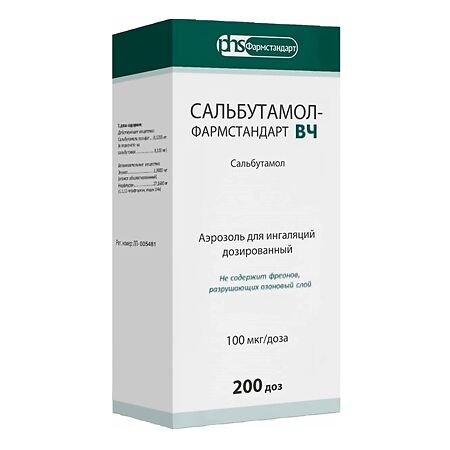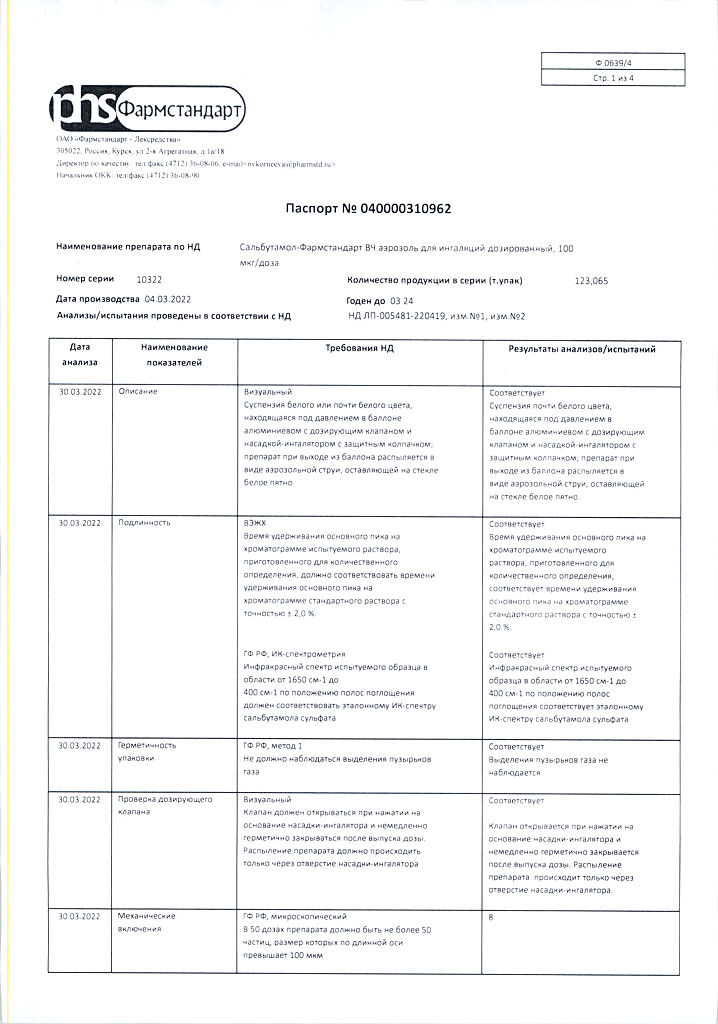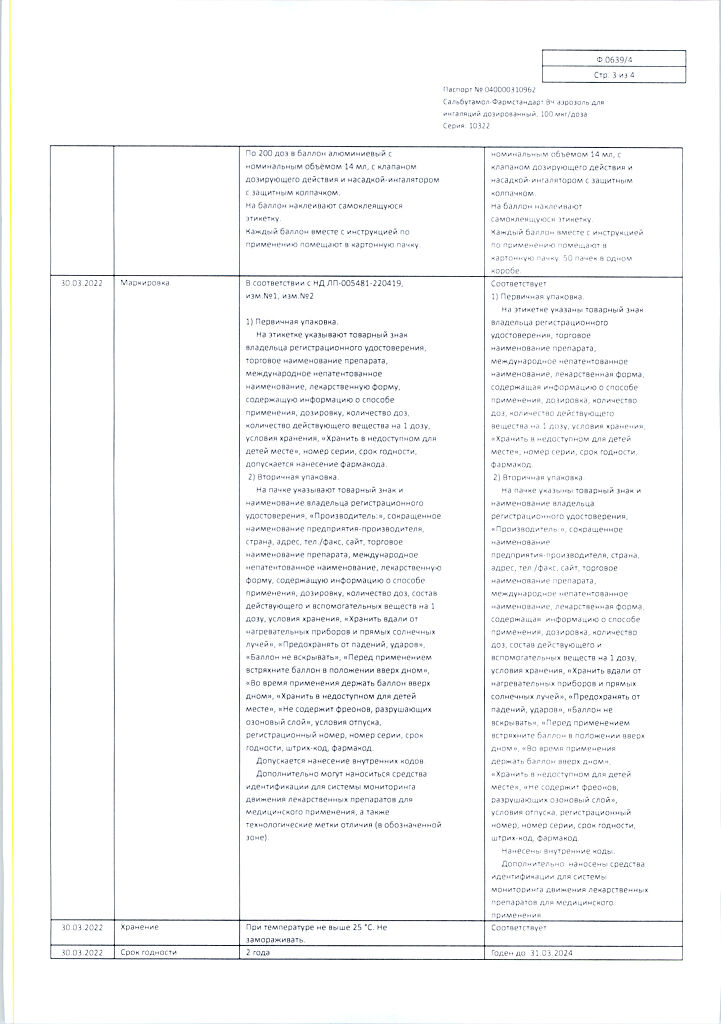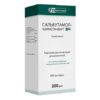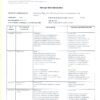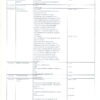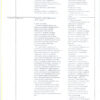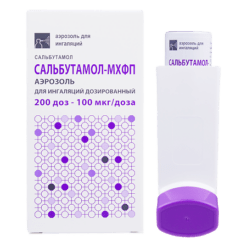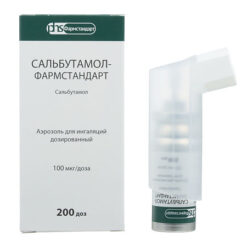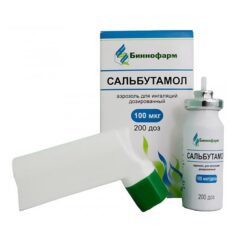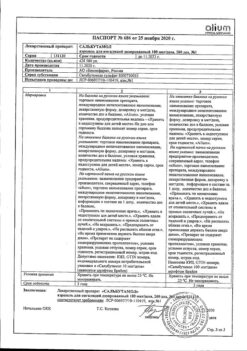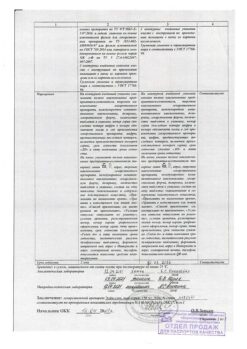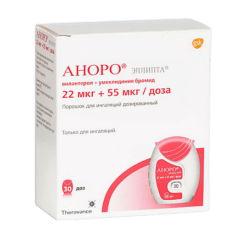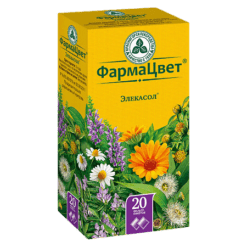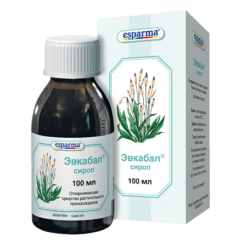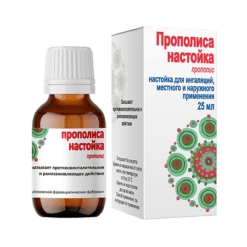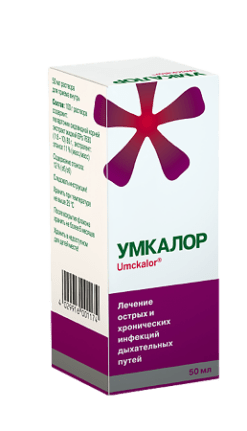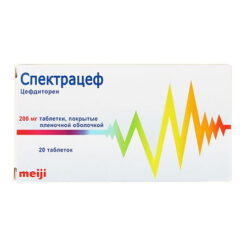No products in the cart.
Salbutamol-Pharmstandart HF, aerosol 100 mcg/dose 200 doses
€4.94 €4.39
Description
Pharmacotherapeutic group: bronchodilator – β2-adrenomimetic selective.
ATX code: R03AC02
Pharmacological properties
Pharmacodynamics
Mechanism of action
Salbutamol is a selective beta2-adrenoreceptor agonist. In therapeutic doses, it acts on beta2-adrenoceptors of bronchial smooth muscle and has a short-term (4 to 6 hours) bronchodilator effect on beta2-adrenoceptors with rapid onset of action (within 5 minutes) in reversible airway obstruction.
It has a pronounced bronchodilator effect, preventing or relieving bronchial spasm, reduces airway resistance. Increases the vital capacity of the lungs. Increases mucociliary clearance (in chronic bronchitis up to 36%), stimulates mucus secretion, activates the functions of the atrial epithelium.
In the recommended therapeutic doses does not have negative effects on the cardiovascular system, does not cause increase in arterial pressure. To a lesser extent compared to the drugs of this group, it has positive chrono- and inotropic effects. It causes dilation of the coronary arteries.
It has a number of metabolic effects: decreases the concentration of potassium in the plasma, affects glycogenolysis and insulin release, has hyperglycemic (especially in patients with bronchial asthma) and lipolytic effects, increases the risk of acidosis.
Pharmacokinetics
absorption
After inhalation, 10-20% of the dose of salbutamol reaches the lower airways. The remainder of the dose remains in the inhaler or is deposited in the oropharynx and then swallowed. The fraction deposited in the respiratory tract is absorbed into lung tissue and blood, but is not metabolized in the lungs.
Distribution
The degree of binding of salbutamol to plasma proteins is 10%.
Metabolism
In the systemic bloodstream, salbutamol undergoes hepatic metabolism and is excreted mainly by the kidneys unchanged or as phenolic sulfate.
The swallowed portion of the inhaled dose is absorbed from the gastrointestinal tract and undergoes significant metabolism during “first passage” through the liver, being converted to phenolic sulfate. The unchanged salbutamol and the conjugate are excreted primarily by the kidneys.
Elimation
Intravenously administered salbutamol has a half-life of 4-6 hours. It is excreted partly by the kidneys and partly by metabolism to 4′-O-sulfate (phenol sulfate), which is also excreted mainly by the kidneys. Only a small part of the administered dose of salbutamol is excreted through the intestine. Most of the dose of salbutamol administered by intravenous, oral or inhalation routes is excreted within 72 hours.
Indications
Indications
1. Bronchial asthma
– relief of symptoms of bronchial asthma when they occur;
-prevention of bronchospasm attacks associated with exposure to an allergen or caused by physical activity;
– use as one of the components in long-term maintenance therapy of bronchial asthma.
2. Other chronic lung diseases accompanied by reversible airway obstruction, including chronic obstructive disease (COPD), chronic bronchitis, emphysema.
Bronchodilators should not be the only or main component of the treatment of unstable or severe bronchial asthma. In the absence of a response to salbutamol in patients with severe bronchial asthma, it is recommended to treat with glucocorticosteroids (GCS) in order to achieve and maintain disease control. Failure to respond to salbutamol therapy may indicate the need for urgent medical consultation or treatment.
Pharmacological effect
Pharmacological effect
Pharmacotherapeutic group: bronchodilator – selective β2-adrenergic agonist.
ATX code: R03AC02
Pharmacological properties
Pharmacodynamics
Mechanism of action
Salbutamol is a selective beta2-adrenergic receptor agonist. In therapeutic doses, it acts on beta2-adrenergic receptors of bronchial smooth muscle and has a short-term (4 to 6 hours) bronchodilatory effect on beta2-adrenergic receptors with a rapid onset of action (within 5 minutes) with reversible airway obstruction.
It has a pronounced bronchodilator effect, preventing or relieving bronchospasm, and reduces resistance in the respiratory tract. Increases vital capacity of the lungs. Increases mucociliary clearance (in chronic bronchitis up to 36%), stimulates mucus secretion, activates the functions of the ciliated epithelium.
In recommended therapeutic doses, it does not have a negative effect on the cardiovascular system and does not cause an increase in blood pressure. To a lesser extent, compared to drugs of this group, it has a positive chrono- and inotropic effect. Causes dilation of the coronary arteries.
It has a number of metabolic effects: it reduces the concentration of potassium in plasma, affects glycogenolysis and insulin secretion, has a hyperglycemic (especially in patients with bronchial asthma) and lipolytic effect, and increases the risk of developing acidosis.
Pharmacokinetics
Suction
After inhalation, 10-20% of the dose of salbutamol reaches the lower respiratory tract. The rest of the dose remains in the inhaler or is deposited in the oropharynx and is then swallowed. The fraction deposited in the respiratory tract is absorbed into the lung tissue and blood, but is not metabolized in the lungs.
Distribution
The degree of binding of salbutamol to plasma proteins is 10%.
Metabolism
When it enters the systemic circulation, salbutamol undergoes hepatic metabolism and is excreted primarily by the kidneys unchanged or in the form of phenolic sulfate.
The ingested portion of the inhalation dose is absorbed from the gastrointestinal tract and undergoes significant first-pass metabolism through the liver to phenolic sulfate. Unchanged salbutamol and the conjugate are excreted primarily by the kidneys.
Removal
Salbutamol administered intravenously has a half-life of 4-6 hours. It is excreted partly by the kidneys and partly as a result of metabolism to 4′-O-sulfate (phenolic sulfate), which is also excreted primarily by the kidneys. Only a small part of the administered dose of salbutamol is excreted through the intestines. Most of the dose of salbutamol administered intravenously, orally or by inhalation is excreted within 72 hours.
Special instructions
Special instructions
Use with caution for tachyarrhythmias and other heart rhythm disorders, arterial hypertension, myocarditis, heart defects, aortic stenosis, diabetes mellitus, thyrotoxicosis, glaucoma, acute heart failure (subject to careful medical supervision).
Increasing the dose or frequency of taking salbutamol should be done under the supervision of a physician. Reducing the interval is possible only in exceptional cases and must be strictly justified.
When using salbutamol, there is a risk of developing hypokalemia, therefore, during treatment in patients with severe bronchial asthma, the level of potassium in the blood should be monitored. The risk of hypokalemia increases with hypoxia.
Active ingredient
Active ingredient
Salbutamol
Composition
Composition
Active ingredient:
salbutamol sulfate 0.1205 mg
(in terms of salbutamol 0.100 mg)
Excipients:
ethanol (absolute ethanol) 1.9000 mg
norflurane (1,1,1,2-tetrafluoroethane, freon 134a) 27.1600 mg
Contraindications
Contraindications
hypersensitivity to salbutamol or any other component of the drug;
children under 2 years of age;
management of preterm birth;
threatened abortion.
With caution
Salbutamol-Pharmstandard HF should be used with caution in patients with tachyarrhythmia; coronary heart disease; myocarditis; heart defects; aortic stenosis; severe chronic heart failure; arterial hypertension; thyrotoxicosis; pheochromocytoma; decompensated diabetes mellitus; glaucoma; as well as during pregnancy and breastfeeding.
Side Effects
Side Effects
The adverse reactions presented below are listed according to the damage to organs and organ systems and the frequency of occurrence. The frequency of occurrence is estimated as follows: very common (≥ 1/10), common (≥ 1/100 and < 1/10), uncommon (≥ 1/1000 and < 1/100), rare (≥ 1/10,000 and < 1/1000), very rare (< 1/10,000, including isolated cases). Frequency categories were formed based on clinical studies of the drug and post-registration surveillance.
Frequency of occurrence of adverse reactions
Immune system disorders: very rarely – hypersensitivity reactions, including angioedema, urticaria, bronchospasm, decreased blood pressure and collapse.
Metabolic and nutritional disorders
Rarely: hypokalemia. Therapy with beta2-agonists may lead to clinically significant hypokalemia.
Nervous system disorders
Common: tremor, headache. Very rare: hyperactivity.
Heart disorders
Often: tachycardia. Uncommon: palpitations. Very rare: arrhythmias, including atrial fibrillation; supraventricular tachycardia and extrasystole.
Vascular disorders
Rarely: peripheral vasodilation.
Respiratory, thoracic and mediastinal disorders
Very rare: paradoxical bronchospasm.
Gastrointestinal disorders
Uncommon: irritation of the mucous membrane of the mouth and pharynx.
Musculoskeletal and connective tissue disorders
Uncommon: muscle cramps.
Interaction
Interaction
The simultaneous use of salbutamol and non-selective beta-adrenergic blockers such as propranolol is not recommended.
Salbutamol is not contraindicated in patients receiving monoamine oxidase inhibitors (MAOIs).
In patients with thyrotoxicosis, salbutamol enhances the effect of central nervous system stimulants and tachycardia.
Theophylline and other xanthines, when used simultaneously, increase the likelihood of developing tachyarrhythmias. Concomitant use with anticholinergic drugs (including inhaled ones) may increase intraocular pressure. Diuretics and corticosteroids enhance the hypokalemic effect of salbutamol.
The interaction of salbutamol with levodopa, inhalation anesthesia agents, MAO inhibitors and tricyclic antidepressants, cardiac glycosides may lead to a risk of a sharp decrease in blood pressure.
Storage conditions
Storage conditions
Store at a temperature not exceeding 25 °C. Do not freeze.
Keep out of the reach of children.
Shelf life
Shelf life
2 years.
Do not use after the expiration date stated on the package.
Manufacturer
Manufacturer
Pharmstandard-Leksredstva, Russia
Additional information
| Shelf life | 2 years. Do not use after the expiration date stated on the package. |
|---|---|
| Conditions of storage | Store at a temperature not exceeding 25 ° C. Do not freeze. Keep out of reach of children. |
| Manufacturer | Pharmstandard-Leksredstva, Russia |
| Medication form | metered aerosol for inhalation |
| Brand | Pharmstandard-Leksredstva |
Other forms…
Related products
Buy Salbutamol-Pharmstandart HF, aerosol 100 mcg/dose 200 doses with delivery to USA, UK, Europe and over 120 other countries.

